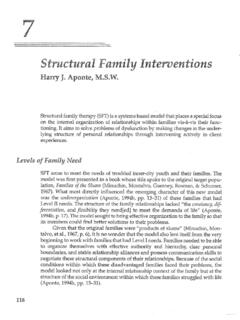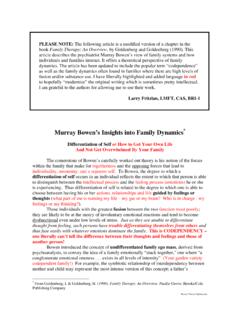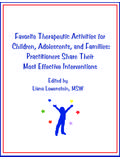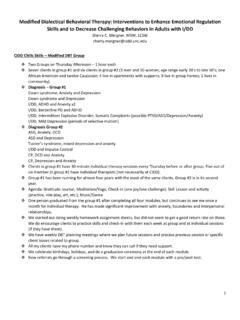Transcription of Targeting Outcomes for a Family: Case Example
1 80 Case PlanningChild Protective Services: A Guide for Caseworkers 81 Parent or caregiver Outcomes . Outcomes for parents or caregivers focus on many areas, such as mental health functioning, problem solving ability, impulse control, substance abuse treatment, and parenting skills. A sample desired outcome is improved child management skills (as evidenced by establishing and consistently following through with rules and limits for children). family Outcomes . Outcomes for the family focus on such issues as roles and boundaries, communication patterns, and social support.
2 A sample desired outcome is enhanced family maintenance and safety (as evidenced by the ability to meet members basic needs for food, clothing, shelter, and supervision). Environmental Outcomes . Sometimes Outcomes focus on the environmental factors contributing to the maltreatment, such as social isolation, housing issues, or neighborhood safety. A sample desired outcome is utilizing social support (as evidenced by a family being adopted by a church that provides child care respite, support group, and family activities).
3 Targeting Outcomes for a family : Case ExampleThe Dawn family consists of the father, Mr. Dawn, age 34; mother, Mrs. Dawn, age 32; daughter, Tina, age 6; and son, Scott, age 31 2. The family was reported to CPS by the daycare center. Scott had lateral bruises and welts on his buttocks and on the back of his thighs. The daycare center reported that Scott was an aggressive child; he throws things when he is angry, hits other children, and runs from the teacher. The center also has threatened not to readmit investigation and family assessment, the caseworker learned that Mr.
4 And Mrs. Dawn have been married for 10 years. Mr. Dawn completed high school and is employed as a clerk in a convenience store. He works the evening shift, 4 to 11 , and was recently turned down for a promotion. Mrs. Dawn also completed high school, went on to become a paralegal, and is employed as a legal assistant. Tina was a planned child, but Scott was not. The parents described Tina as a quiet and easy child. They described Scott as a difficult child and as having a temper and not minding adults. Recently, he threw a truck at his sister, causing her to need stitches above her eye, and tore his curtains down in his bedroom.
5 His parents described Scott as unwilling to be held and loved. Both parents are at their wits end and do not know what to do with Scott. Mrs. Dawn reported that all of the discipline falls on her, and she cannot control home appeared chaotic with newspapers, toys, and magazines strewn all over the living room. There was no evidence of structure or consistent rules. Scott misbehaved during the interview. Sometimes the parents ignored his behavior, and other times they addressed his behavior only when it had escalated to the point that he was out of control.
6 It also appeared that Tina had a lot of age-inappropriate responsibility, for Example , making Scott s breakfast every Dawn said his mother used severe forms of punishment when he misbehaved. He feels it taught him right from wrong, believing that children need strong discipline to grow up into healthy, functioning adults. He said he often sees red when Scott misbehaves and that he yells at Scott or hits Scott with a nearby family is socially isolated. Mr. Dawn s mother is alive, but they are estranged. Mrs. Dawn s parents are deceased, and her two brothers live hundreds of miles away.
7 Mrs. Dawn has a friend at work, but they do not communicate outside of work. The parents described being very much in love when they met. However, because of work schedules, they have very little time to spend together. Mrs. Dawn describes her husband as often yelling at her and the children rather than just talking. 80 Case PlanningChild Protective Services: A Guide for Caseworkers 81 Targeting Outcomes for a family : Case ExampleThe behaviors and conditions contributing to the risk include: Father s poor impulse control Father s childhood history of abuse Father s aggressive behavior Lack of structure, rules, and limits Inconsistent and inappropriate discipline family isolation Inappropriate role expectations Poor family communication Scott s poor impulse control Scott s aggressive and dangerous behaviorSample parent Outcomes may be improved impulse control, child management skills.
8 And coping family Outcomes may be improved communication and family child Outcomes may be improved and age-appropriate behavioral GOALS Caseworkers should work with families to develop goals that indicate the specific changes needed to accomplish the Outcomes . The objective is not to create a perfect family or a family that matches a caseworker s own values and beliefs. Rather, the goal is to reduce or eliminate the risk of maltreatment so that children are safe and have their developmental needs met. Goals should be SMART; in others words, they should be: Specific.
9 The family should know exactly what has to be done and why. Measurable. Everyone should know when the goals have been achieved. Goals will be measurable to the extent that they are behaviorally based and written in clear and understandable language. Achievable. The family should be able to accomplish the goals in a designated time period, given the resources that are accessible and available to support change. Realistic. The family should have input and agreement in developing feasible goals. Time limited.
10 Time frames for goal accomplishment should be determined based on an understanding of the family s risks, strengths, and ability and motivation to change. Availability and level of services also may affect time frames. 82 Case PlanningChild Protective Services: A Guide for Caseworkers 83 83 Goals should indicate the positive behaviors or conditions that will result from the change and not highlight the negative TASKS Goals should be broken down into small, meaningful, and incremental tasks. These tasks incorporate the specific services and interventions needed to help the family achieve the goals and Outcomes .

















